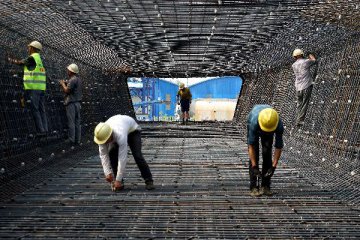The Chinese authorities are studying policies to further promote the merger and reorganization of the steel enterprises, on the basis of completing the crude steel de-capacity task for the 13th Five-year Plan period (2016-2020) two years in advance, according to the Xinhua-run Economic Information Daily on Friday.
During 2016-2020, China plans to cut up to 150 million metric tons (tonnes) of crude steel capacity.
It is reported that the authorities will encourage qualified steel enterprises to implement cross-regional and cross-ownership mergers and acquisitions (M&As) in an effort to accelerate the transformation and upgrading of the domestic steel industry.
The domestic steel industry has entered the stage of innovation-based optimization and upgrading from the stage of investment-driven scale expansion in the past. Against such background, the steel industry needs to build a quality-centered brand evaluation system, promote the transition from manufacturers to service providers, and increase the capacity of supplying high-end steel products, said Xia Nong, an official of the National Development and Reform Commission (NDRC).
It is worth noting that compared with developed countries, the steel industry in China still faces the problem of low concentration.
In 2017, output of China's top ten steel enterprises accounted for less than 37 percent of the country's total, said Zhang Zhixiang, president of the China Chamber of Commerce for Metallurgical Enterprises.
According to data of the Lange Steel Information Research Center, in 2017, the combined output of the top two steel companies in the Republic of Korea (ROK) accounted for 89.2 percent of the total national output. Output of the top three steel companies in Japan accounted for 81.5 percent of the total national output. The top four steel enterprises in Russia accounted for 78.0 percent of the country's total output. Output of the top three steel companies in the United States accounted for 57.7 percent of the country's total output.
From the current point of view, it is expected that the output of the top ten Chinese steel enterprises will account for 60 percent in three years, said Zhao Xizi, honorary president of the China Chamber of Commerce for Metallurgical Enterprises.
During 2016-2020, China plans to cut up to 150 million metric tons (tonnes) of crude steel capacity.
It is reported that the authorities will encourage qualified steel enterprises to implement cross-regional and cross-ownership mergers and acquisitions (M&As) in an effort to accelerate the transformation and upgrading of the domestic steel industry.
The domestic steel industry has entered the stage of innovation-based optimization and upgrading from the stage of investment-driven scale expansion in the past. Against such background, the steel industry needs to build a quality-centered brand evaluation system, promote the transition from manufacturers to service providers, and increase the capacity of supplying high-end steel products, said Xia Nong, an official of the National Development and Reform Commission (NDRC).
It is worth noting that compared with developed countries, the steel industry in China still faces the problem of low concentration.
In 2017, output of China's top ten steel enterprises accounted for less than 37 percent of the country's total, said Zhang Zhixiang, president of the China Chamber of Commerce for Metallurgical Enterprises.
According to data of the Lange Steel Information Research Center, in 2017, the combined output of the top two steel companies in the Republic of Korea (ROK) accounted for 89.2 percent of the total national output. Output of the top three steel companies in Japan accounted for 81.5 percent of the total national output. The top four steel enterprises in Russia accounted for 78.0 percent of the country's total output. Output of the top three steel companies in the United States accounted for 57.7 percent of the country's total output.
From the current point of view, it is expected that the output of the top ten Chinese steel enterprises will account for 60 percent in three years, said Zhao Xizi, honorary president of the China Chamber of Commerce for Metallurgical Enterprises.




















Latest comments